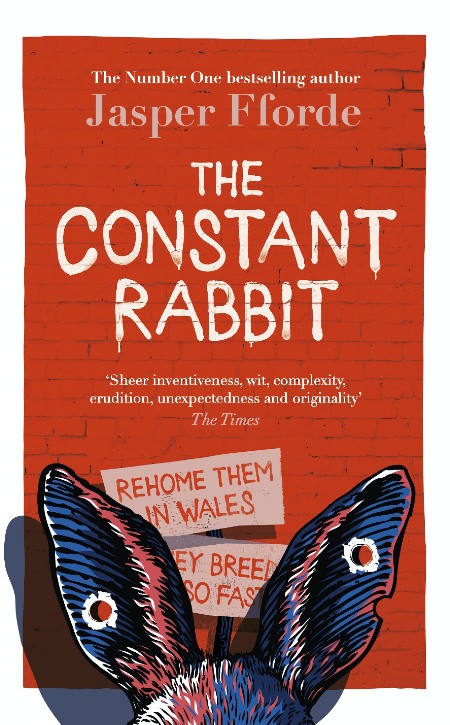
If there is one thing at which Jasper Fforde excels, and let’s face there are many (have you read his books? Read and learn the breadth of this writer’s extensive talents), it is the ability to wrap hard, made-of-steel truths inside an outer wrapping of appealing wit, whimsy and quirk.
It’s the literary equivalent of Mary Poppins using sugar to make the medicine go down, and it works an absolute carrot-y treat in The Constant Rabbit, in which we find ourselves in a Britain where a Spontaneous Anthropomorphic Event in the 1950s (still unexplained) has rendered a select group of rabbits (mostly), foxes, bees and a badger along with some other animals capable of human speech and thought and a cultural appreciation which sees them clearly ascend to the dizzying heights of vital sentience.
Eighteen affected rabbits have now becomes one million, spread among four main burrows around the United Kingdom and out among the populace (though that requires a permit) and they have, in the decades since their strange transformation into a heady mix of Leporidae and human, shown themselves eminently capable of appreciating rabbit-ised version of Shakespeare and Austen, serving in the armed forces, going to university and in general being fine upstanding and avowedly vegetarian members of society.
But they are also different, and you know how a frighteningly large proportion of humanity hates anything different.
“Much Hemlock had always been a hotbed of right-wing sentiment, something that had strong historical precedent: the village had the dubious distinction of having convicted and burned more witches than any other English town in history. Thirty-one, all told, right up until a dark night in 1568 when they burned a real one bu accident, and all her accusers came out in unsightly black pustules and died hideously painful deaths within forty-eight hours. Zephaniah Mallett has been the magistrate during the trials, but in a dark day for evolution, he’d has children before dying so four centuries later Victor and Norman were very much in existence. They liked to keep family traditions alive, even if witch-burning was currently off limits.” (P. 15)
While the rabbits featured in The Constant Rabbit comes across as fine examples of studied thoughtfulness and integrity – indeed, at one point, the book muses that if they were in charge of the UK, something the rabidly fearful simultaneously raise and decry as a possibility, things would likely be far better and caringly run (another recurring theme of the book are budgetary cutbacks and the way they eat at the fabric of society) – they are actively campaigned against, with a political entity, the United Kingdom Anti-Rabbit Party (remember of anything?), doing their best to stoke fear and division instead of unity and inclusion.
Amidst all this rampant leporidiphobia, Peter Knox, who to his low-simmering but often ignored shame works for a department dedicated to keeping rabbits well and truly in their place, finds out that a rabbit family is moving to his village of Much Hemlock, a place that is picture postcard pretty with an obsessive intention to win a Best Kept Village award but which, for all its loveliness, hides a darkly anti-rabbit heart.
The rabbit family in question, his old university friend Constance Rabbit and her third husband Major Rabbit (rabbits still die from many causes including Myxomatosis and duels) and their two children Bobby and Kent – hers from a previous marriage – simply want a quiet life in a quintessential English village but that is, of course, not acceptable to many of the villagers who see the family as the leading front of a rabbit army that will swamp them and take away their rights and freedoms and land.
That’s not what Constance or her fellow rabbits want, but then when have facts ever got in the way of a good scare campaign or virulent, unfounded paranoia?
It is here that The Constant Rabbit utterly excels.

Using its quirky and deliciously idiosyncratic premise brilliantly, The Constant Rabbit does a thought-provoking job of taking the literally whitewashed face of racism off and showing the murky, horrific depths that lurk behind it.
The genius of this approach is that as you chortling, and chortle you most certainly will, at the hilariously offbeat English village names, the snappy oneliners and the absurd sense of surreality that infuses this perfectly-executed novel, you suddenly realise how much of an iron fist is sitting inside its quirkily velvet glove.
So powerfully is its transformative message woven into its jaunty, oft-silly visage that you can be reading about the ability of rabbits to come up with a thousand different carrot recipes, so far so silly and delightfully so, when talk suddenly turns to the MegaWarren in Wales (essentially a concentration camp with pretty new buildings and slick PR) or cultural differences so acute and poorly understood that the only solution might be violence.
In that sense, Fforde, who has long demonstrated an incisive ability to satirise the ills of our time in settings appealingly left of centre, is a heir to a long tradition of British writing which seems charmingly and mirth-inducing two or three hundred steps off mainstream until you dig down and realise how much hard-hitting and necessary to confront truth is hiding in plain sight in funny place names and absurdist ideas.
It’s a very clever approach, and The Constant Rabbit lives and breath to such a beguiling degree that laughter and horror almost go hand in hand.
“‘It’s madame Bovary being read out loud in real time,’ said Bobby. ‘rabbits are very into french literature at the moment, and phones are often hijacked to help rabbits on the production lines deal with boredom through the injection of a little Flaubertian virtuosity. There’ll be an announcement at the end asking if you’d like to pledge a few pounds if you liked it. They’ll do anything to make money in the colonies. Madame Bovary is a firm favourite – kind of racy, you see – Emma would have made a fine rabbit. Best of all it pisses off UKARP – they’re not fans of any literature that isn’t British.'” (P. 145)
As does a growing appreciation for how broken this thing we call humanity often is, especially in an age which has forgotten the hard-won lessons of last century and seems hellbent on returning to a world defined by violent bigotry, authoritarianism and nightmarish fascist intent.
Peter Knox seems like a fine, upstanding human being, and in many ways he actually is, but by being complicit in the anti-rabbit agenda of his workplace, and not taking an active stand to support Constance and her family (who are subjected to an active campaign, backed by considerable dollars, to drive them out) he is, in fact, subjugating whatever his fine qualities may be to bigotry and hatred.
Not actively, he assures himself, but as his daughter Pippa becomes close friends with some rabbits and he understands what is at stake if he doesn’t stand up for his Leporidae friends, he has to confront the kind of person he is and wants to be.
The answers aren’t easy to come by but as events escalate, and again in ways magically silly and frighteningly intensely dark, he has no choice to make a decision, one that will upend his life and change his allegiances for the rest of his life.
The Constant Rabbit is a gem of a book, a startlingly and immersively clever story that has all the charming English wit and whimsy you could ask for, all of which is in deadly serious service to unmasking one of the great evils of ours or any time and which succeeds in delivering a tale that is both gorgeously silly and arrestingly, life-changingly thoughtful, proof that sugar really does help the medicine go down and hopefully changes the world for the better as it does so.